JAPANESE BUDDHIST TEMPLES
Buddhist temples in Japan are places of worship not shrines (sacred places for praying). Shrines are usually associated with Shintoism. A Buddhist temple generally contains an image of Buddha and has a place where Buddhists practice devotional activities. Temples attract large crowds during festivals or if they are famous but otherwise a fairly quiet. They are often sought as places for quiet meditation, with most acts of worship and devotion being done in front of an altar at home.
There are around 70,000 Buddhist temples in Japan. In Japan regular attendance at Buddhist temples is rare, partly because many Buddhist sects do not observe communal worship. Buddhist temples in Japan range from massive structures and complexes, such as Todaiji, Honganji, and Koya-san, to small single structures. They can be found in mountains, villages, towns, and cities. Holy places include natural sites (for example, waterfalls, mountains, caves), as well as pilgrimage destinations and gardens. The most famous pilgrimage is the Shikoku pilgrimage, associated with Kūkai, with 88 major holy sites. The burial sites or mausoleums of famous figures, including those of Kukai and Shinran, attract many pilgrims even today. There may be less temples than before, By one count there were nearly 75,000 temples and 204,000 priests in the early 1990s.[Source: Gary Ebersole, Worldmark Encyclopedia of Religious Practices, Thomson Gale, 2006; Library of Congress, 1994]
A local Buddhist temple typically serves as the residence of a married cleric and his family. The temple is supported by lay member, for whom it provides rituals and festivals, occasional pastoral care, and especially funerals and memorial services. These local institutions typically represent branch temples (matsuji) of the many denominations or schools (shū) into which Buddhism is divided. Religious corporations registered with the government are typically centered in a main temple (honzan). The main temple serves as symbolic and administrative headquarters.[Source: Carl Bielefeldt, Encyclopedia of Buddhism, Gale Group Inc., 2004 =]
The larger denominations may include several monastic centers, parochial schools, and universities, and can claim thousands of local temples. The denominations of Buddhism, whether large or small, operate as independent religious entities. They have their own clergy, real property, distinctive scriptures, and rituals, as well as lay membership. =
Large Kyoto temples, such as Chionin temple — the head temple of Jodoshu Buddhism? have no danka (community-support system) and are run like large companies. The 150 priests who work at Chionin receive a salary from the temple. The majority of the salaried priests have their own small temples elsewhere, but the support of their danka alone is not enough. They use their Chionin salaries to subsidize their own small temples, much like Sakakibara used his salary from the university to sustain his temple.
Temples and Shrines in Nara Park Kofukuji site kohfukuji.com ; Yamasa UNESCO World Heritage site: UNESCO website; Todaiji Temple Wikipedia Wikipedia UNESCO World Heritage site: UNESCO website Toshodaiji Japan Guide japan-guide.com UNESCO World Heritage site: UNESCO website Mt. Koya: Koyasan Shingon Buddhism koyasan.or.jp ; Wikipedia Wikipedia ; Wikitarvel Wikitravel UNESCO World Heritage site: UNESCO website Temple Lodging (shukabo) Temple Lodging in Japan Temple Lodging in Japan ; Japan Guide Mt. KoyaJapan Guide Mt. Koya
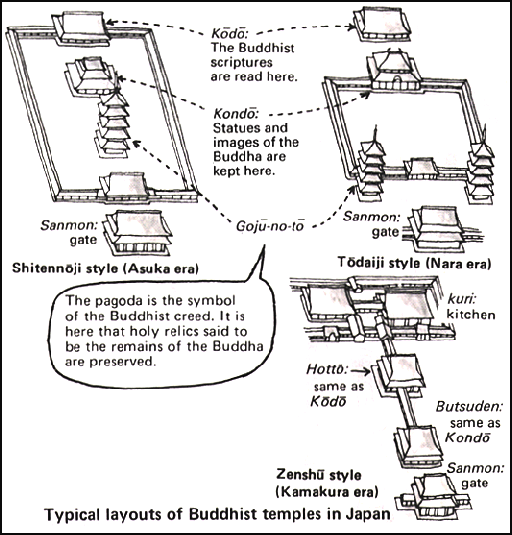
Japanese Buddhist Temple Architecture
Buddhist temples are generally clusters of buildings, whose number and size depends on the size of the temple. Large temples have several halls, where people can pray, and living quarters for monks. Smaller ones have a single hall, a house for a resident monk and a bell. Some have cemeteries.
The architecture of Buddhist temples is influenced by the architecture of Korea and China, the two countries that introduced Buddhism to Japan. Early Japanese Buddhist temples consisted of pagodas, which were modeled after Chinese-style pagodas, which in turn were modeled after Indian stupas. Over time these pagodas became one building in a large temple complex with many buildings.
Buddhist temples built in the 7th century featured vermillion-painted columns and eaves supported and decorated with mythical beasts sculpted in "dry-lacquer" (layers of hemp cloth glued together and covered with lacquer) or guilt bronze. Unfortunately no original examples of this style of architecture remains. The earliest Buddhist paintings had a strong Indian influence.
Types of Buddhist Temples and Buildings in Japan
There are three main types of Buddhist Temples: 1) Japanese style (“wayo”), 2) Great Buddha style (“daibutsuyo”), and 3) Chinese style (“karayo”). These in turn vary according to the Buddhist school and the historical period in which they built.
The main hall (“kondo” or “hondo”) is usually found at the center of the temple grounds. Inside are images of the Buddha, other Buddhist images, an altar or altars with various objects and space for monks and worshipers. The main hall is sometimes connected to a lecture hall.
A monk at Mtizuzoin Temple in Tokyo told the Daily Yomiuri,”When people think of temple, they tend to think of it as a shadowy, scary kind of place. This is because temples have long been regarded as being associated with death. This stems from the fact that many people only visit the temple for Buddhist rites” for the dead.
Other buildings include a lecture hall (“kodo”), where monks gather to study and chant sutras; the sutra depository (“kyozo”), a place where Buddhist scripture are kept, and often shaped like a log cabin on stilts; living, sleeping, and eating areas for monks; and offices. Large temples often have special halls, where treasures are kept and displayed. Some have a pagoda. Many temples have small shops that sell religious items.
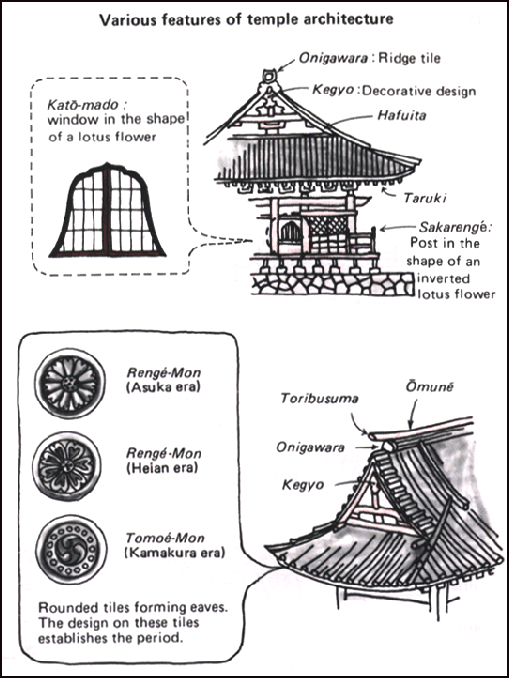
Features of Buddhist Temples in Japan
Japanese style pagodas have multiple stories, each with a graceful, tiled Chinese-style roof, and a top roof capped by a spire.
The central images in the main hall is often surrounded by burning incense sticks and offerings of fruit and flowers. Inside the temple there is one set of wooden plaques with the names of large contributors and another set the afterlife names of deceased people. In the old days the afterlife names were only given to Buddhist priests but over time they were given to lay people who paid enough money and now are almost used as ranking system in the after life.
Many Buddhist temples contain large bells, which are rung during the New Year and to mark other occasions, and cemeteries. Chion-in Temple in Kyoto contains the largest bell in Japan (a massive 74-ton bronze made in 1633). Ringing the massive bell requires 17 monks, 16 of them to raise the giant wooden hammer by pulling it away from the bell with hanging ropes, while the 17th monk rides the hammer, ready to push off with his legs in the split second before impact. The chime produced by the bell lasts for 20 minutes. When Albert Einstein visited Chion-in in 1922 he investigated the bell and said that the assertion that the bell was inaudible directly underneath it when it was struck was based on sound physics.
Many temples use concrete that has been expertly camouflaged to look like wood. Near many Buddhist temples are stone Jizo figures with red bibs and a staff in one hand and a jewel in the other. They honor the souls of children who have died or been aborted. See Above.
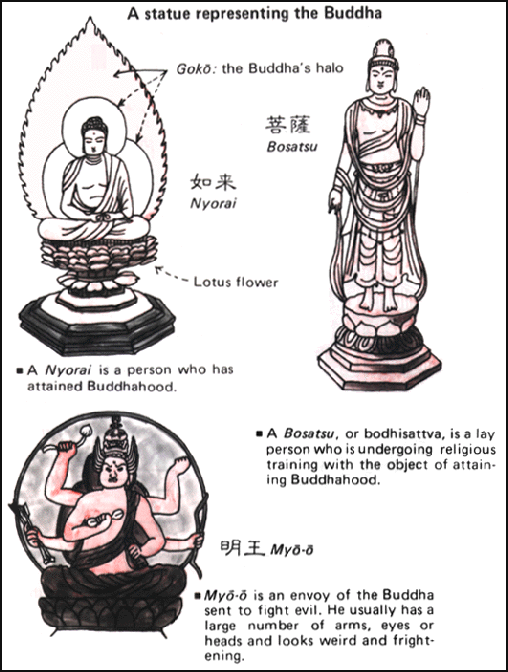
Buddhist Images in Japan
There are four main types of Buddhist sculptures found in Buddhist temples, each conveying a different level of being in Buddhist cosmology: 1) “Nyorai” (“images of Buddha”); 2) “bosatsu” (“bodhisattvas”); 3) deities and spirits such as “ten” (“heavenly being or devas”) and “nio” (“guardian tens”); and 4) “myoo” (“kings of wisdom and light that serve as protectors of Buddhism”). The most common myoo, Fudo Myoo, is usually a menacing-looking holding an upright sword.
Bosatsu are distinguishable from nyorai by a more human like appearance and a top knot of hair or a crowed headpiece, sometimes with smaller figures in the crown. One of the most common bodhisattvas found in Japanese temples is Jizo, a bodhisattva who helps children and travelers. Kannon (Avalokitesvara) appears in 33 different manifestations, including the Goddess of Mercy, is also very popular, especially with pregnant mothers.
Nyorai images are recognizable by their simple robes, lump on the head (symbolizing wisdom) and "snail shell" curls of hair. Common images found in temples include 1) Shaka (the Historical Buddha), recognizable by one hand raised in a praying gesture; 2) Yakushi (the Healing Buddha), with one hand raised in the praying gesture and the other holding a vial of medicine; 3) Amita (Buddha of the Western Paradise), sitting down with the knuckles together in a meditative position; 4) Dainichi (the Cosmic Buddha), usually portrayed with in princely clothes, with one hand clasped around a raised a finger on the other hand (a sexual gesture indicating the unity of being; and Maitreya (Buddha of the Future).
Nyorai images are often depicted with two bodhisattvas in a triad configuration and/or are backed by a nimbus a (large wooden board with Buddha and other images carved or painted on them).
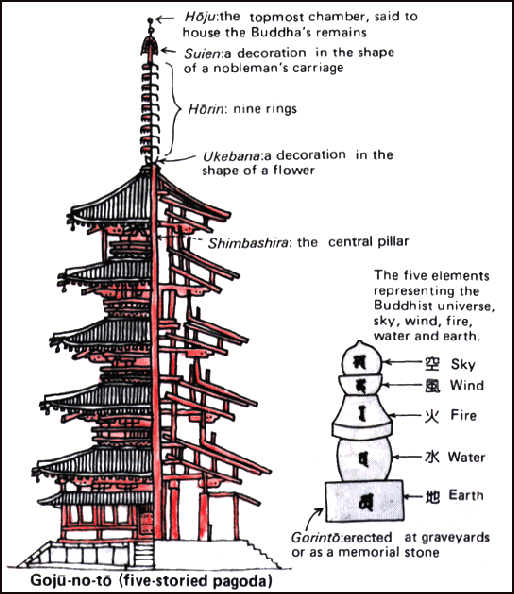
Japanese-style pagoda
Temple Gates at Japanese Buddhist Temples
Buddhist temples usually have outer gates and inner gates protected by statues or paintings of beasts, fierce gods, or warriors that ward off evil spirits. The gateways are composed of wood, stone, bronze or even concrete. The beasts include Chinese lions and Korean dogs. Fierce guardian gods and warriors on the outer gate sometime have lighting bolts coming out of their nostrils and a serrated swords in their hands. Their duty is to keep demons and evil spirits out of the temple area.
The inner gate at the antechamber to the temple complex is often guarded by four guardian kings, representing the four cardinal directions. The king in the north holds a pagoda representing earth, heaven and cosmic axis. The king in the east holds a sword with the power to evoke a black wind that produces tens of thousands of spears and golden serpents. The king in the west possesses lute. And the king in the south holds a dragon and a wish-fulfilling jewel.
Some demon statues are covered with spitballs from worshipers who wrote prayers or petitions on pieces of paper, chewed them, and threw them on the demon statues in hope that the prayers would be answered. Usually they are folded paper.
Temple Worship, Rituals and Etiquette in Japan
Temples are places where people pray, meditate participate in religious ceremonies, make offerings, light incense and candles, offer food to monks, meditate alone or in groups, chant mantras, listen to monks chant mantras, attend lectures or discussions led by respected teachers . Individual may also seek counseling from monks on nuns on personal matters. Buddhists are not required to visit temples.
Japanese Buddhists worship statues of Buddhas and bodhisattvas made of wood, bronze, and stone. These statues are believed to embody the deities. Statues of Buddhist prelates were also made and became objects of worship from the Kamakura period onwards. Mandalas are also sacred objects in Tendai and Shingon Buddhism. Sacred sites include mountains, valleys, and tombs or grave sites of famous religious figures. In Japan, Mahayana Buddhism emphasizes nonduality, which dissolves all distinctions, including those between the sacred and the profane, and form and emptiness. [Source: Gary Ebersole, Worldmark Encyclopedia of Religious Practices, Thomson Gale, 2006]
One needs to take one's shoes off only if entering a temple. Hats should also be removed. Do not clap at Buddhist temples as you would at a Shinto shrine. Praying is done by prostrating oneself or bowing with hands clasped from a standing or seated position in front of an image of Buddha. Prayers are usually made after tossing a coin into the saisen-bako (offering box).
Offerings left at Shinto shrines and Buddhist temples include coins, apples, business cards. Many Japanese visiting temples and shrines attach omiyuki folded paper fortunes to trees in the belief it will bring them good fortune. At some Buddhist temples visitors pay ¥300 for the privilege of writing the prayers on wooden rice spatulas.
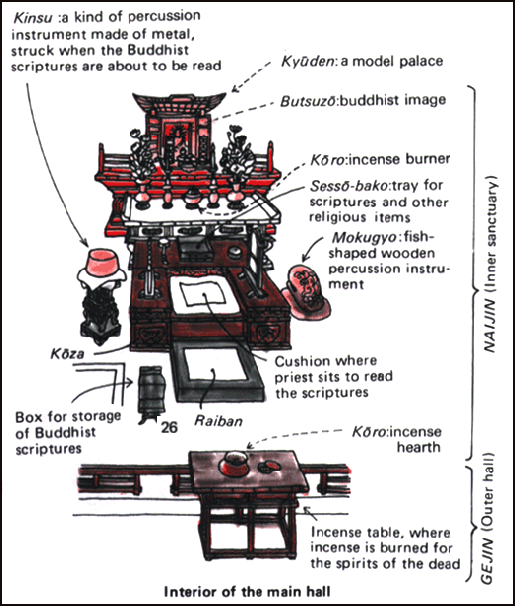
Hiraizumi Temples
Hiraizumi Temples, Gardens and Archaeological Sites of the Pure Land Buddhist school was named a UNESCO World Heritage Site in 2011. According to UNESCO: “Hiraizumi – Temples, Gardens and Archaeological Sites Representing the Buddhist Pure Land comprises five sites, including the sacred Mount Kinkeisan. It features vestiges of government offices dating from the 11th and 12th centuries when Hiraizumi was the administrative centre of the northern realm of Japan and rivalled Kyoto. The realm was based on the cosmology of Pure Land Buddhism, which spread to Japan in the 8th century. It represented the pure land of Buddha that people aspire to after death, as well as peace of mind in this life. In combination with indigenous Japanese nature worship and Shintoism, Pure Land Buddhism developed a concept of planning and garden design that was unique to Japan.
“The four temple complexes of this once great centre with their Pure Land gardens, a notable surviving 12th century temple, and their relationship with the sacred Mount Kinkeisan are an exceptional group that reflect the wealth and power of Hiraizumi, and a unique concept of planning and garden design that influenced gardens and temples in other cities in Japan....The Pure Land Gardens of Hiraizumi clearly reflect the diffusion of Buddhism over south-east Asia and the specific and unique fusion of Buddhism with Japan's indigenous ethos of nature worship and ideas of Amida's Pure Land of Utmost Bliss. The remains of the complex of temples and gardens in Hiraizumi are symbolic manifestations of the Buddhist Pure Land on this earth.
See Separate Article: NEAR SENDAI: HIRAIZUMI, MATSUSHIMA ISLANDS factsanddetails.com
How Some Temples in Japan Investment Their Money
ESG bonds refer to any bond with set environmental, social, or governance objectives. This can include everything from affordable housing to improved infrastructure, reduction of racial or gender inequity, or renewable energy. Green bonds specifically focus on issues related to the climate and environment.
In 2021, Bloomberg reported: ESG investing is so popular in Japan that even Buddhist monks are getting into it. “One of the new investors is Tokuunin, a Zen Buddhist temple in central Tokyo. The religious group wanted to make more money for building repairs and maintenance over the coming decades, so it bought 40-year social bonds sold by the University of Tokyo, according to Yuzan Yamamoto, its chief priest. “At a time when we can barely get any returns from long-term savings, we’re happy that we can contribute to helping society while earning enough returns to cover inflation,” Yamamoto said. [Source: Ayai Tomisawa, Bloomberg, January 14, 2021]
“He’s not alone. Nomura Securities Co. has been finding that more and more Buddhist temples and Shinto shrines are interested in buying environmental, social and governance bonds, according to Satoshi Tsukazaki, who consults religious organizations at the brokerage. It’s another reflection of the sustainable investing boom in Japan that saw sales of ESG notes jump 68 percent to a record $21 billion in 2020, as demand for such debt surges worldwide.
“Japanese religious organizations are also under pressure to earn more from investing because a shrinking population in the country is reducing the number of their followers that can pay for their operations. Membership in religious groups has dropped about 12 percent in the decade to 2019, according to government data. The coronavirus pandemic took its toll as well. In normal years people flock to Japan’s about 160,000 shrines and temples at the start of the year, but many stayed away in 2021 due to the virus, depriving religious groups of some income from donations.
“Those developments have prompted temples and shrines to rethink a bit what they do with cash raised from followers that in the past they kept in conservative investments such as bank savings and government bonds. “They’ve started taking various risks such as on currencies and interest rates, and began buying ESG bonds,” said Tsukazaki at Nomura. “They think ESG investing is an appropriate way of using their followers’ money.”
Image Sources: Ray Kinnane Visualizing Culture, MIT Education, JNTO
Text Sources: New York Times, Washington Post, Los Angeles Times, Daily Yomiuri, Times of London, Japan National Tourist Organization (JNTO), National Geographic, The New Yorker, Time, Newsweek, Reuters, AP, Lonely Planet Guides, Compton’s Encyclopedia and various books and other publications.
Last updated January 2024
